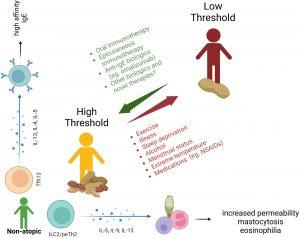Food allergies are a significant public health issue, with individuals experiencing a range of reactions, from mild discomfort to life-threatening anaphylaxis. One of the key factors in managing food allergies is understanding the “eliciting dose” (ED)—the minimum amount of an allergen that can trigger a reaction. The threshold level varies significantly across individuals, and this variability highlights the need for personalized approaches to food allergy management.
Recent studies have shown that while IgE levels and skin prick tests can help predict a person’s ED, they do not fully explain why some individuals react to very small amounts of an allergen, while others can tolerate more. The expansion of allergen-specific T helper 2 cells (TH2 cells) is another factor influencing ED, independent of IgE concentration. Thus, determining a person’s threshold involves complex immune responses that go beyond traditional testing methods

Figure 1: Relationship between eliciting dose threshold in IgE-mediated food allergy with IgE, peTH2, cofactors, and therapeutics. Created with BioRender.com. IL, interleukin; ILC2, type 2 innate lymphoid cells; NSAIDs, nonsteroidal anti-inflammatory drugs; peTH2, pathogenic effector helper T2 cells; Tfh13, T follicular helper 13 cells.
Understanding these thresholds has significant implications for clinical practice, particularly in the context of oral immunotherapy (OIT). OIT aims to gradually increase a patient’s tolerance to an allergen by exposing them to increasing doses over time. Knowledge of a patient’s specific ED allows for more tailored and effective treatment strategies. Moreover, identifying a patient’s threshold can reduce unnecessary dietary restrictions, particularly with precautionary allergen labelling (PAL). Many food products with PAL contain minimal or no allergen residues, meaning individuals with higher thresholds could confidently consume such products without risking severe reactions.
The ED01 and ED05 levels, which correspond to the amount of allergen that would trigger a reaction in 1% and 5% of the population, respectively, are often used to assess risk at the population level. However, these values need to be integrated into real-world scenarios, particularly when evaluating PAL-labelled products. There is growing evidence that many foods with precautionary labels contain allergen residues far below the levels that would trigger reactions in the majority of people with allergies
In conclusion, understanding food allergy thresholds is vital for improving patient care and reducing the burden of food allergies. Tailored management strategies that take into account individual ED levels, along with better regulation and understanding of PAL, can lead to more effective treatments and improved quality of life for those living with food allergies.
Journal Article: Li, Jennifer C, et al. “Utility of Food Allergy Thresholds.” Annals of Allergy, Asthma, & Immunology.
Summary by Faith Oluwamakinde










